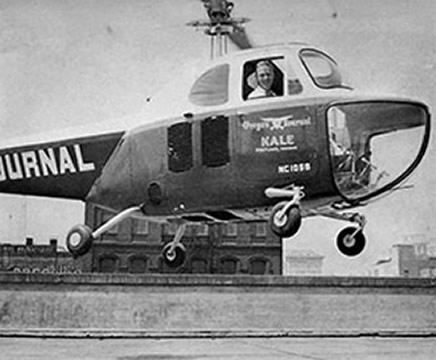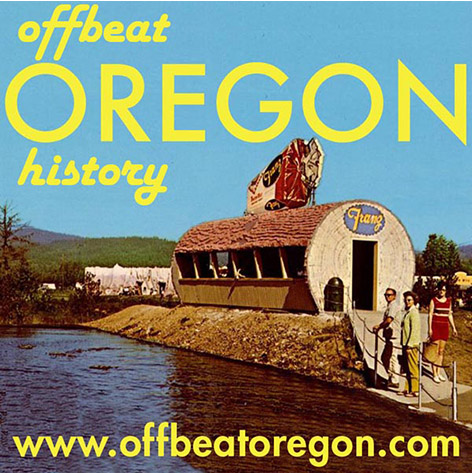PORTLAND, MULTNOMAH COUNTY; 1940s:
Copter crash decimated Oregon journalism
Audio version: Download MP3 or use controls below:
|

The helicopter was a sensation. It was the first news helicopter in the country. All summer long, Sam flew it around Portland. When news broke, he’d run for the chopper with a photographer and go get the story, with pictures the Oregonian couldn’t match — usually with a little logo at the bottom right reading “Journal Copter Photo.” Probably the high point of the Journal’s triumph was when a fire broke out in the Oregonian building, and they were able to fly over and get aerial photographs of their rival’s building with smoke billowing out of it. By the end of the year, the Journal’s little eggbeater was a familiar sight in Portland, and the Journal had prepared a picture book full of images it had captured. They titled it “The Newsroom Dragonfly.” But before it could be published, came the evening of Dec. 21, 1947. Sam Jackson had flown the helicopter to the home of his friend Ambrose Cronin — who was, ironically enough, a grandson of Henry Pittock — where he had been invited for dinner. He arrived a little early, so Jackson invited Cronin to come up for a quick spin around the neighborhood. The two of them flew out over a nearby golf course while other dinner guests watched. Then, reaching the other side, Jackson apparently tried to turn too quickly. The dinner guests and family members watched in horror as the helicopter, with the scions of two newspaper empires aboard, stalled and dove 100 feet into the ground, where it bounced once and burst into flames.
So when, six years later, Philip Jackson died of heart trouble, the only surviving members of the family were Sam Jackson I’s widow, Maria, and Sam Jackson II’s 11-year-old son, Peter. So it was necessary to look outside the family circle for a publisher. William Knight, the newspaper’s attorney, was tapped for the job, and the newspaper’s ownership was put into a trust. Maria stipulated that if it were ever necessary to sell the paper, it must be to a local owner, preferably to the paper’s employees, even if an out-of-towner offered more money. She probably was thinking of one out-of-town owner in particular: S.I. Newhouse of New York, who had bought The Oregonian in a distress sale after it had financially crippled itself trying to build a big deluxe new office building. Newhouse wanted the Journal badly, and everyone knew it. Well, the story of how Newhouse got his wish as an effect of an extended strike by the stereotypers’ union has been told before in this column. Newhouse was either very lucky, incredibly clever, or both; but by 1961, Maria had been dead for several years, and the Journal’s trustees sold out to him for the astonishingly modest sum of $8 million, or about $67 million in modern currency. After that, with Knight still at the helm, the Journal basically took over the role that the Evening Telegram had filled four decades earlier: a junior paper, fully owned by the Oregonian, with a separate and competitive newsroom (but now on a different floor rather than in a different building). The news departments competed with each other, but the Oregonian got more resources with which to compete, and the reading public wasn’t really fooled. In most respects, Portland was now a de-facto one-newspaper town, and everyone knew it. And in 1982, when Newhouse made it official by fully folding the Journal into the Oregonian, hardly anyone seemed to notice. None of this would, of course, have happened if Sam Jackson II had survived to take the helm at the Oregon Journal.
|
Background photo of Crater Lake in wintertime as seen from the rim was made by WolfmanSF in 2012. (Via WikiMedia Commons, cc/by/SA)
Scroll sideways to move the article aside for a better view.
Looking for more?
On our Sortable Master Directory you can search by keywords, locations, or historical timeframes. Hover your mouse over the headlines to read the first few paragraphs (or a summary of the story) in a pop-up box.
... or ...

©2008-2018 by Finn J.D. John. Copyright assertion does not apply to assets that are in the public domain or are used by permission.

